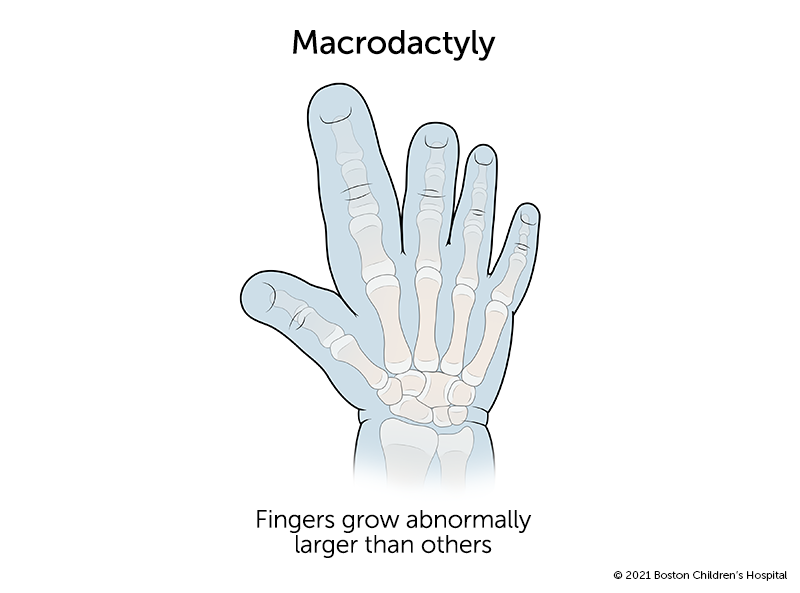Macrodactyly | Symptoms & Causes
What are the symptoms of macrodactyly?
If your child has macrodactyly, one or more of their digits will be much larger than the others.
- Most cases of macrodactyly are static, which means that the enlarged digits grow at the same rate as the rest of your child’s hand or foot.
- When macrodactyly is progressive, the affected digits grow faster than the rest of the hand or foot.
If your child has static macrodactyly, their affected fingers or toes will generally be about one-and-a-half times the length and width of the unaffected digits. If their condition is progressive, the involved fingers or toes can become enormous.
What causes macrodactyly?
Researchers do not know why some children are born with macrodactyly. The condition does not appear to be caused by anything the mother did (or did not do) during pregnancy. Although babies are born with it, macrodactyly is not passed down from parents to children.
Macrodactyly can occur in association with other conditions and syndromes, including:
- neurofibromatosis
- vascular malformations
- multiple enchondromatosis
- tuberous sclerosis
- Maffucci syndrome
Macrodactyly | Diagnosis & Treatments
How is macrodactyly diagnosed?
Your child’s doctor probably will see signs of macrodactyly soon after your child is born. However, if your child has the progressive kind, it may not be detected right away. Your child will have an x-ray and may have an MRI (magnetic resonance imaging) of their hand or foot to provide more information about the enlarged tissues.
How is macrodactyly treated?
The goal of treatment is to ensure your child’s hand or foot has the most function and best appearance possible.
In mild cases, treatment may involve watching your child’s hand or foot carefully over time.
In more severe cases, your child’s doctor may recommend surgery. Unfortunately, there is no simple procedure for thinning and shortening the affected fingers or toes since all parts of the digits (bones, tendons, nerves, blood vessels) are larger than normal.
Your child’s doctor may recommend some combination of the following surgical procedures:
- Soft tissue debulking, which aims to correct the width of your child’s affected digits. It involves the surgical removal of the thickened layers of skin and fat and the replacement of skin with healthy skin. This procedure is usually performed in several stages around three months apart. It’s more often used to treat the milder forms of macrodactyly or as a part of the treatment of the more progressive forms.
- Shortening procedures, which aim to correct length and usually involve surgical removal of a section of bone from affected area.
- Ray resection, which involves surgical removal of the entire finger or toe. This may be recommended when the condition is progressive, and the affected fingers or toes grow at a faster rate than the rest of the hand or foot.
What is the long-term outlook for children with macrodactyly?
The long-term outlook for a child treated for macrodactyly varies from child to child and the severity of their condition. While surgery can improve the appearance and function of your child’s hand, it’s likely the affected fingers or toes will still look and move differently.
How we care for macrodactyly at Boston Children’s Hospital
The Orthopedics and Sports Medicine Department’s Hand and Orthopedic Upper Extremity Program and our Department of Plastic and Oral Surgery’s Hand and Reconstructive Microsurgery Program have treated thousands of babies and children with macrodactyly and other hand problems. We are experienced treating conditions that range from routine to highly complex, and can provide your child with expert diagnosis, treatment, and care. We also offer the benefits of some of the most advanced clinical and scientific research in the world.
Our Orthopedics and Sports Medicine Department is nationally known as the preeminent center for the care of children and young adults with a wide range of developmental, congenital, neuromuscular, sports-related, traumatic, and post-traumatic problems of the musculoskeletal system.
Our Department of Plastic and Oral Surgery is one of the largest and most experienced pediatric plastic and oral surgery centers anywhere in the world. We provide comprehensive care and treatment for a wide variety of congenital and acquired conditions, including hand deformities.



